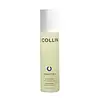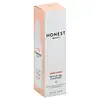What's inside
What's inside
 Key Ingredients
Key Ingredients

 Benefits
Benefits

 Concerns
Concerns

 Ingredients Side-by-side
Ingredients Side-by-side

Water
Skin ConditioningSodium Lauryl Glucose Carboxylate
CleansingCoco-Betaine
CleansingLauryl Glucoside
CleansingPEG-120 Methyl Glucose Dioleate
EmulsifyingEthylhexylglycerin
Skin ConditioningGlycerin
HumectantPanthenol
Skin ConditioningAloe Barbadensis Leaf Juice
Skin ConditioningCitrus Paradisi Peel Oil
MaskingAllantoin
Skin ConditioningPelargonium Graveolens Flower Oil
MaskingLavandula Angustifolia Oil
MaskingRosmarinus Officinalis Leaf Oil
MaskingCinnamomum Camphora Bark Oil
MaskingCupressus Sempervirens Oil
MaskingChlorphenesin
AntimicrobialSorbic Acid
PreservativeTocopherol
AntioxidantPotassium Sorbate
PreservativeSodium Benzoate
MaskingCoco-Glucoside
CleansingGlyceryl Oleate
EmollientSodium Chloride
MaskingPEG-40 Hydrogenated Castor Oil
EmulsifyingSodium Citrate
BufferingDisodium EDTA
Citric Acid
BufferingLimonene
PerfumingHydrogenated Palm Glycerides Citrate
EmollientWater, Sodium Lauryl Glucose Carboxylate, Coco-Betaine, Lauryl Glucoside, PEG-120 Methyl Glucose Dioleate, Ethylhexylglycerin, Glycerin, Panthenol, Aloe Barbadensis Leaf Juice, Citrus Paradisi Peel Oil, Allantoin, Pelargonium Graveolens Flower Oil, Lavandula Angustifolia Oil, Rosmarinus Officinalis Leaf Oil, Cinnamomum Camphora Bark Oil, Cupressus Sempervirens Oil, Chlorphenesin, Sorbic Acid, Tocopherol, Potassium Sorbate, Sodium Benzoate, Coco-Glucoside, Glyceryl Oleate, Sodium Chloride, PEG-40 Hydrogenated Castor Oil, Sodium Citrate, Disodium EDTA, Citric Acid, Limonene, Hydrogenated Palm Glycerides Citrate
Water
Skin ConditioningSodium Laurylglucosides Hydroxypropylsulfonate
CleansingGlycerin
HumectantSodium Methyl Cocoyl Taurate
CleansingCocamidopropyl Hydroxysultaine
CleansingSodium Chloride
MaskingSorbitol
HumectantSodium Lauryl Glucose Carboxylate
CleansingLauryl Glucoside
CleansingCalendula Officinalis Flower Extract
MaskingChamomilla Recutita Flower Extract
MaskingYucca Schidigera Root Extract
Skin ConditioningSaponaria Officinalis Extract
Skin ConditioningLeuconostoc/Radish Root Ferment Filtrate
AntimicrobialHydrolyzed Quinoa
Skin ConditioningLavandula Angustifolia Oil
MaskingLavandula Hybrida Oil
EmollientPelargonium Graveolens Flower Oil
MaskingPogostemon Cablin Leaf Oil
MaskingAnthemis Nobilis Flower Oil
MaskingCymbopogon Martini Oil
MaskingAbies Sibirica Oil
MaskingGluconolactone
Skin ConditioningPotassium Sorbate
PreservativeSodium Benzoate
MaskingCoconut Acid
CleansingSodium Citrate
BufferingCitric Acid
BufferingSorbic Acid
PreservativeLinalool
PerfumingWater, Sodium Laurylglucosides Hydroxypropylsulfonate, Glycerin, Sodium Methyl Cocoyl Taurate, Cocamidopropyl Hydroxysultaine, Sodium Chloride, Sorbitol, Sodium Lauryl Glucose Carboxylate, Lauryl Glucoside, Calendula Officinalis Flower Extract, Chamomilla Recutita Flower Extract, Yucca Schidigera Root Extract, Saponaria Officinalis Extract, Leuconostoc/Radish Root Ferment Filtrate, Hydrolyzed Quinoa, Lavandula Angustifolia Oil, Lavandula Hybrida Oil, Pelargonium Graveolens Flower Oil, Pogostemon Cablin Leaf Oil, Anthemis Nobilis Flower Oil, Cymbopogon Martini Oil, Abies Sibirica Oil, Gluconolactone, Potassium Sorbate, Sodium Benzoate, Coconut Acid, Sodium Citrate, Citric Acid, Sorbic Acid, Linalool
 Reviews
Reviews

Ingredients Explained
These ingredients are found in both products.
Ingredients higher up in an ingredient list are typically present in a larger amount.
Citric Acid is an alpha hydroxy acid (AHA) naturally found in citrus fruits like oranges, lemons, and limes.
Like other AHAs, citric acid can exfoliate skin by breaking down the bonds that hold dead skin cells together. This helps reveal smoother and brighter skin underneath.
However, this exfoliating effect only happens at high concentrations (20%) which can be hard to find in cosmetic products.
Due to this, citric acid is usually included in small amounts as a pH adjuster. This helps keep products slightly more acidic and compatible with skin's natural pH.
In skincare formulas, citric acid can:
While it can provide some skin benefits, research shows lactic acid and glycolic acid are generally more effective and less irritating exfoliants.
Most citric acid used in skincare today is made by fermenting sugars (usually from molasses). This synthetic version is identical to the natural citrus form but easier to stabilize and use in formulations.
Read more about some other popular AHA's here:
Learn more about Citric AcidGlycerin is already naturally found in your skin. It helps moisturize and protect your skin.
A study from 2016 found glycerin to be more effective as a humectant than AHAs and hyaluronic acid.
As a humectant, it helps the skin stay hydrated by pulling moisture to your skin. The low molecular weight of glycerin allows it to pull moisture into the deeper layers of your skin.
Hydrated skin improves your skin barrier; Your skin barrier helps protect against irritants and bacteria.
Glycerin has also been found to have antimicrobial and antiviral properties. Due to these properties, glycerin is often used in wound and burn treatments.
In cosmetics, glycerin is usually derived from plants such as soybean or palm. However, it can also be sourced from animals, such as tallow or animal fat.
This ingredient is organic, colorless, odorless, and non-toxic.
Glycerin is the name for this ingredient in American English. British English uses Glycerol/Glycerine.
Learn more about GlycerinLauryl Glucoside sugar- and lipid-based cleansing agent. It is created from glucose and lauryl alcohol.
This ingredient is a surfactant, making it easier to rinse oil, dirt, and other pollutants away.
A British study found lauryl glucoside to cause skin sensitivity for some people. We recommend speaking with a professional if you have concerns.
Other names for this ingredient include "Lauryl Polyglucose", "Lauryl glycoside", and "D-Glucopyranoside".
Learn more about Lauryl GlucosideLavandula Angustifolia Oil is more commonly known as lavender essential oil. It is considered a fragrancing ingredient.
Lavender imparts a famous scent. While the smell is lovely, this ingredient and may sensitize skin in topical products. This is because about 85% of the oil is made up of linalool and linalyl acetate.
When exposed to air, these two compounds become strong allergens. This ingredient exhibits cytotoxicity at low concentrations; amounts of 0.25% have been shown to damage skin cells.
A study from Japan found this ingredient caused lavender sensitivity after widespread exposure.
Lavender essential oil has some antimicrobial, antibacterial, and anti-inflammatory properties. However, the cons of this ingredient may outweight the pros.
More research is needed to confirm lavender essential oil's effects when used in aromatherapy.
Lavandula Angustifolia is known as the English Lavender and famous for creating purple fields in Provence, France.
Learn more about Lavandula Angustifolia OilPelargonium Graveolens Flower Oil is the pressed oil of the Rose Geranium plant. It is volatile, meaning it evaporates off the skin.
Fragrant components of Rose Geranium include citronellol and geraniol. These may cause allergies and skin-sensitivity. We recommend speaking with a professional if you have any concerns.
The scent of Rose Geranium closely resembles traditional roses.
Learn more about Pelargonium Graveolens Flower OilPotassium Sorbate is a preservative used to prevent yeast and mold in products. It is commonly found in both cosmetic and food products.
This ingredient comes from potassium salt derived from sorbic acid. Sorbic acid is a natural antibiotic and effective against fungus.
Both potassium sorbate and sorbic acid can be found in baked goods, cheeses, dried meats, dried fruit, ice cream, pickles, wine, yogurt, and more.
You'll often find this ingredient used with other preservatives.
Learn more about Potassium SorbateSodium Benzoate is a preservative. It's used in both cosmetic and food products to inhibit the growth of mold and bacteria. It is typically produced synthetically.
Both the US FDA and EU Health Committee have approved the use of sodium benzoate. In the US, levels of 0.1% (of the total product) are allowed.
Sodium benzoate works as a preservative by inhibiting the growth of bacteria inside of cells. It prevents the cell from fermenting a type of sugar using an enzyme called phosphofructokinase.
It is the salt of benzoic acid. Foods containing sodium benzoate include soda, salad dressings, condiments, fruit juices, wines, and snack foods.
Studies for using ascorbic acid and sodium benzoate in cosmetics are lacking, especially in skincare routines with multiple steps.
We always recommend speaking with a professional, such as a dermatologist, if you have any concerns.
Learn more about Sodium BenzoateChances are, you eat sodium chloride every day. Sodium Chloride is also known as table salt.
This ingredient has many purposes in skincare: thickener, emulsifier, and exfoliator.
You'll most likely find this ingredient in cleansers where it is used to create a gel-like texture. As an emulsifier, it also prevents ingredients from separating.
There is much debate on whether this ingredient is comedogenic. The short answer - comedogenic ratings don't tell the whole story. Learn more about comegodenic ratings here.
The concensus about this ingredient causing acne seems to be divided. Research is needed to understand if this ingredient does cause acne.
Scrubs may use salt as the primary exfoliating ingredient.
Learn more about Sodium ChlorideSodium Citrate is the sodium salts of citric acid. In skincare, it is used to alter pH levels and acts as a preservative.
Its main functions are to maintain the pH of a product and neutralize metal ions.
The acidity of our skin is maintained by our glands and skin biome; normal pH level of skin is slightly acidic (~4.75-5.5).
Being slightly acidic allows our skin to create an "acid mantle". This acid mantle is a thin barrier that protects our skin from bacteria and contaminants.
Learn more about Sodium CitrateWe don't have a description for Sodium Lauryl Glucose Carboxylate yet.
Sorbic Acid is a preservative. It is the most commonly used food preservative in the world.
Sorbic Acid is a natural antibiotic and highly effective at preventing the growth of fungus. It is less effective against bacteria.
Potassium Sorbate, another commonly-used preservative, is the potassium salt of Sorbic Acid.
Sorbic Acid may worsen eczema. We recommend speaking with a professional if you have any concerns.
Potassium sorbate and sorbic acid can be found in baked goods, cheeses, dried meats, dried fruit, ice cream, pickles, wine, yogurt, and more.
Learn more about Sorbic AcidWater. It's the most common cosmetic ingredient of all. You'll usually see it at the top of ingredient lists, meaning that it makes up the largest part of the product.
So why is it so popular? Water most often acts as a solvent - this means that it helps dissolve other ingredients into the formulation.
You'll also recognize water as that liquid we all need to stay alive. If you see this, drink a glass of water. Stay hydrated!
Learn more about Water